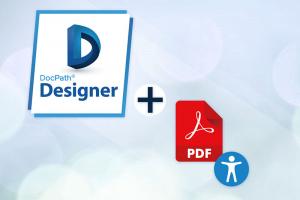Generate accessible PDF documents according to new banking regulations with DocPath V6
DocPath, the leader in innovative document software solutions, announces the compliance with Payment Services of Order ECE 1263/2019 effective July 1, 2020
TRES CANTOS, MADRID, SPAIN, December 3, 2020 /EINPresswire.com/ -- DocPath, the leader in innovative document software solutions, announces that both its DocPath® Designer v.6 design tool and its powerful DocPath® DocGeneration Engine v6 generation engine allows their customers now to comply with the Payment Services following the Order ECE 1263/2019 that took effect on July 1, 2020, from now on accessible PDF documents can be generated.
This order on accessibility in PDF documents demands that documents from financial institutions made available to their customers should be compatible with the applications that allow reading these kinds of documents. In order for the visually impaired customers to have full access to this information, PDFs need to be accessible.
The main accessibility aspects covered in PDF documents are oriented towards the Blind & Visually Impaired (OBVI). Nevertheless, there are other disability types besides the Visually impaired, such as: motor, auditory, cognitive, low vision, etc., which should also be taken into account when accessible PDF documents are being created. The recommendations to make PDF documents accessible are similar to those given for accessible web pages (HTML).
How to comply with this new Order, ECE 1263/2019, for Payment Services effective since July 1, 2020 (accessible PDF documents)
The Web Content Accessibility Guidelines (WCAG 2.0) W3C were taken as the starting point.
These documents must contain computer-generated texts.
There are two different types of PDF documents available:
Scanned documents with images require an Optical Character Recognition (OCR) process to convert images into text.
Text files created directly by word processors or design programs such as DocPath® Designer v.6. These documents are likely to be accessible.
The document must be a tagged PDF.
A tagged PDF document is a PDF version that includes the content of the document and the according to information about its logical structure and reading order, so the document can be read correctly by screen readers.
The fact that a PDF document is correctly labeled does not guarantee its accessibility, as the obtained documents will be as accessible as the original documents on which they are based. If the source document contains images for which no alternative texts have been provided, then they will not be included within the resulting PDF document and they will therefore be inaccessible.
Logical reading order
Clear directions to determine the reading order of the text should be provided in order for a screen reader to efficiently read the information of a page. The reading order of a document may not be clear when working with columns, tables, etc., in order to specify the logical reading order, tagged PDF documents that identify the different blocks and elements of the text which make a structure of the document should be used, such as titles, chapters or headers.
Alternative text for images
In order to provide the user with information about the image, a descriptive text that can be read (alternative text) should be provided.
Document language
Documents can be read in different ways depending on the language that has been used (different pronunciation, accent, intonation, etc.). Therefore, in order to make the document accessible, it is advisable to specify the language in which the document is written.
Links
The document should contain well-defined and useful links to guide them easily to other parts within the document, so users will be guided directly to the section of their interest.
Navigation
Navigation and organization tools are required to make a PDF document accessible, such as table of contents, bookmarks or headers, this helps the user to find what they are looking for, they will easily navigate through the entire document without the need to read the whole content.
Color contrast
An adequate contrast between the text and the background is an important topic as well to facilitate reading for visually impaired customers.
DocPath has made a significant effort to generate accessible PDF documents by using a simple, clear and efficient process to allow compliance with the Payment Services of Order ECE 1263/2019, effective since July 1, 2020
For more information, visit: www.docpath.com/
About DocPath
DocPath is a leading document software manufacturer that provides its worldwide customers with the technology that allows them to implement sophisticated Customer Communication and Document Output Management processes. Created in 1993, DocPath´s solutions have been implemented in companies all over the world. Among its international clients are prestigious banks and first-class corporations, which are aided by DocPath solutions by simplifying the complicated and critical tasks involving the design and distribution of business and customer documents. DocPath maintains a strong commitment to R&D&i, an area that receives a good amount of its revenue, and in which lies the key to the company´s success.
Disclaimer: DocPath is a DocPath Corp. registered trademark. All rights reserved. Other mentioned trademarks may be the property of their respective owners.
Nele Goderis - Communications Manager
DocPath
+34 918 03 50 00
email us here
Document software adapted to the needs of your business
Legal Disclaimer:
EIN Presswire provides this news content "as is" without warranty of any kind. We do not accept any responsibility or liability for the accuracy, content, images, videos, licenses, completeness, legality, or reliability of the information contained in this article. If you have any complaints or copyright issues related to this article, kindly contact the author above.

